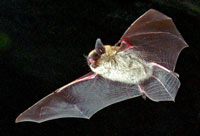Eastern small-footed myotis
Scientific name: Myotis leibii

Cover photo credit: Brock Fenton
Status
Endangered
"Endangered" means the species lives in the wild in Ontario but is facing imminent extinction or extirpation.
Date added to the Species at Risk in Ontario List
June 27, 2014
What it looks like
The eastern small-footed bat (myotis) is about 8 cm long and weighs just 4-5 grams (about the weight of a nickel). Their wing span is 21-25 cm.
This bat’s fur has black roots and shiny light brown tips, giving it a yellowish-brown appearance. Its face mask, ears and wings are black, and its underside is grayish-brown. Males and females are similar in color and size.
This bat’s name is fitting – its feet are only 7-8 mm long.
Eastern small-footed bats live about 6-12 years in the wild.
Where it lives
In the spring and summer, eastern small-footed bats will roost in a variety of habitats, including in or under rocks, in rock outcrops, in buildings, under bridges, or in caves, mines, or hollow trees.
These bats often change their roosting locations every day. At night, they hunt for insects to eat, including beetles, mosquitos, moths, and flies.
In the winter, these bats hibernate, most often in caves and abandoned mines. They seem to choose colder and drier sites than similar bats and will return to the same spot each year.
Where it’s been found in Ontario
The eastern small-footed bat has been found from south of Georgian Bay to Lake Erie and east to the Pembroke area. There are also records from the Bruce Peninsula, the Espanola area, and Lake Superior Provincial Park. Most documented sightings are of bats in their winter hibernation sites.
What threatens it
Eastern small-footed bats are threatened by white nose syndrome, which is caused by a fungus believed to have been inadvertently brought from Europe to North America.
The fungus grows in humid, cold environments, such as the caves and mines where many bats hibernate. The syndrome disrupts the hibernation cycle, so that bats use up body fat supplies before the spring when they can once again find food sources.
It is also thought that the fungus affects the wing membrane, which helps to maintain water balance in bats. Thirst may wake bats from hibernation, which may be why infected animals can be seen flying outside caves and mines during the winter.
In Ontario, bat populations dropped by more than 90% in eight hibernation sites with more than two years’ exposure to white nose syndrome. Bats at more than three quarters of Ontario’s hibernation sites are at high risk of disappearing due to white nose syndrome. Mass die-offs mean that there are no individuals left to reproduce.
Eastern small-footed bats may be less susceptible to this syndrome than other species, since they tend to hibernate in the cooler, drier part of the cave where the fungus may be less virulent. However, in New York State, population declines of 78% in this species have been attributed to white nose syndrome.
Wind turbines are another threat to this bat. Its magnitude is not known.
Action we are taking
Endangered Species and their general habitat are automatically protected
Recovery strategy
A recovery strategy advises the ministry on ways to ensure healthy numbers of the species return to Ontario.
Read the executive summary and full document (June 15, 2017)
Government response statement
A government response statement outlines the actions the government intends to take or support to help recover the species.
Read the government response statement (February 27, 2018)
Review of Progress
A review of progress made toward protecting and recovering a species is required no later than the time specified in the species’ government response statement, or not later than five years after the government response statement is published if no time is specified.
Read the report on progress towards the protection and recovery of 11 species at risk, including Eastern Small-footed Myotis (2023).
What you can do
Report a Sighting
- If you spot an eastern small-footed bat, report your sighting to the Natural Heritage Information Centre. Observations submitted by the public are very important in informing recovery planning, stewardship projects and other conservation initiatives for species at risk in Ontario. Whenever possible, include detailed location information and a photograph with your observation.
Volunteer
- Volunteer with your local nature club or provincial park to participate in surveys or stewardship work focused on species at risk.
Be a good steward
- Don’t enter non-commercial caves and abandoned mines where bats may be present. Avoid visiting caves and abandoned mines where white nose syndrome has been identified.
- Report any unusual bat behaviour or deaths to the Canadian Wildlife Health Cooperative at 1-866-673-4781 or the Natural Resources Information and Support Centre at 1-800-667-1940 .
- Consider building a bat box for your property. Learn more about how to build one and where to set it up.
- Private land owners have a very important role to play in species recovery. You may be eligible for stewardship programs that support the protection and recovery of species at risk and their habitats.
Report illegal activity
- Report any illegal activity related to plants and wildlife to 1-877-TIPS-MNR (847-7667).
Quick facts
- The eastern small-footed bat is the smallest bat and one of the rarest bats in eastern North America.
- When they are born, these bats weigh a fifth to a third of their mother’s weight.